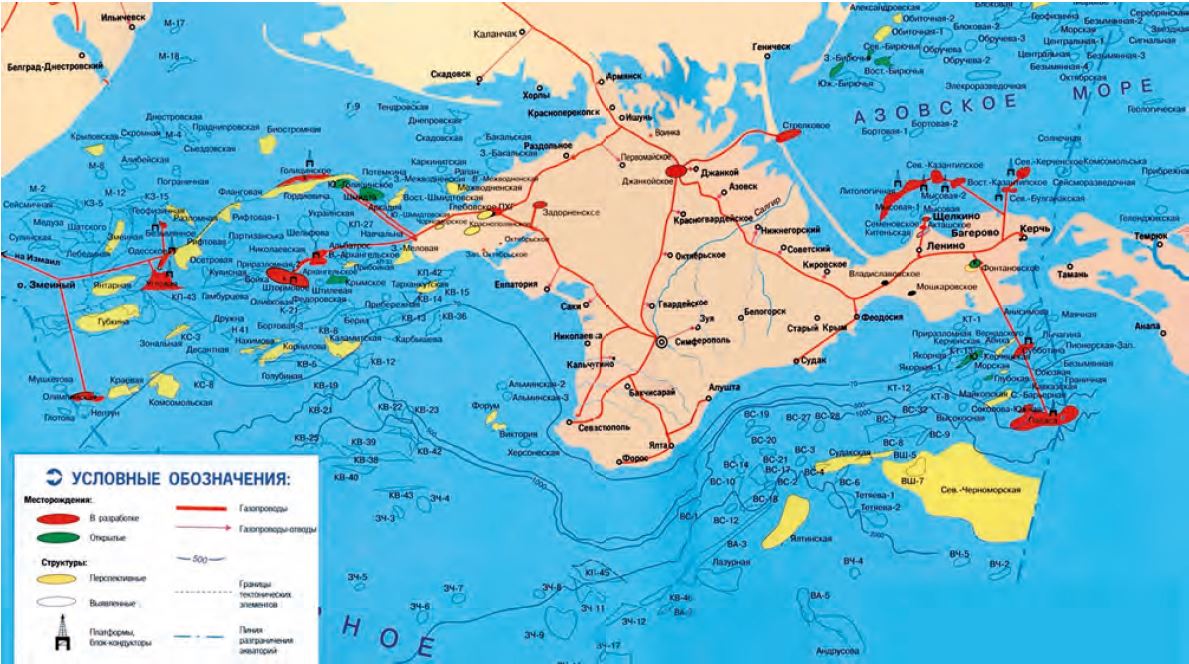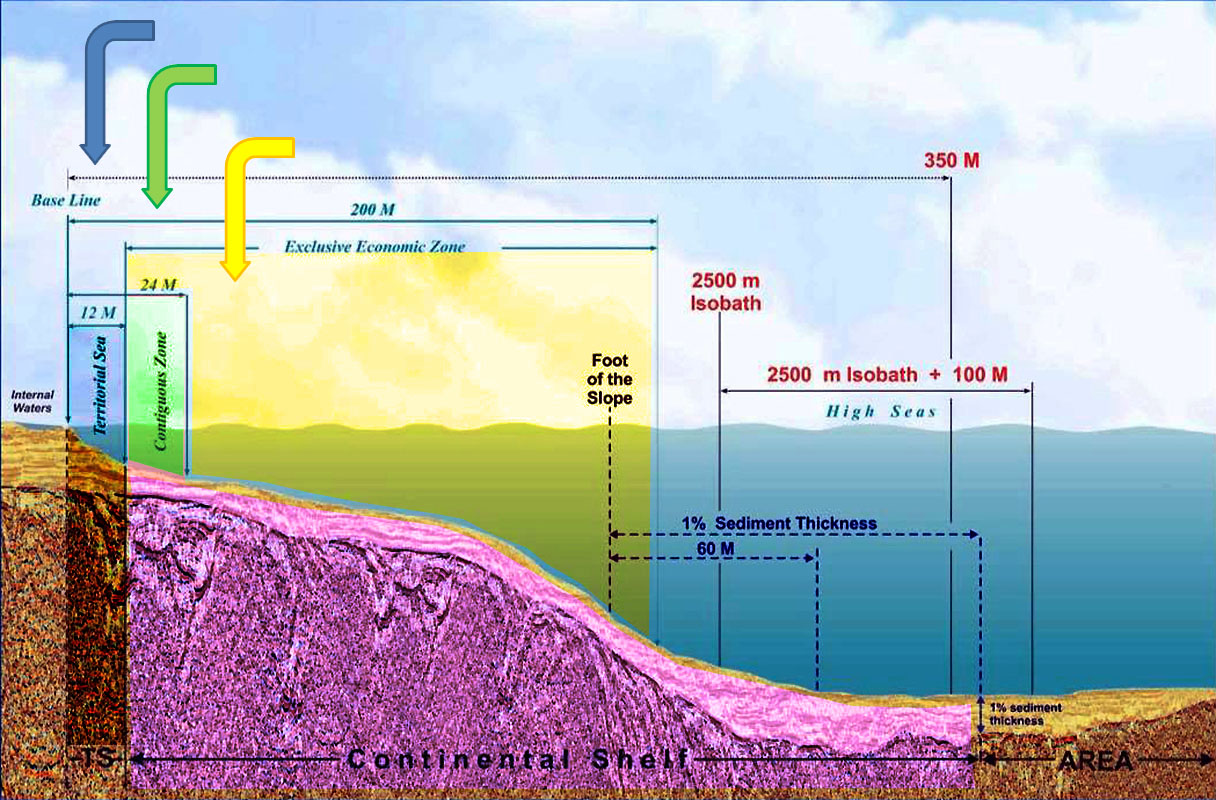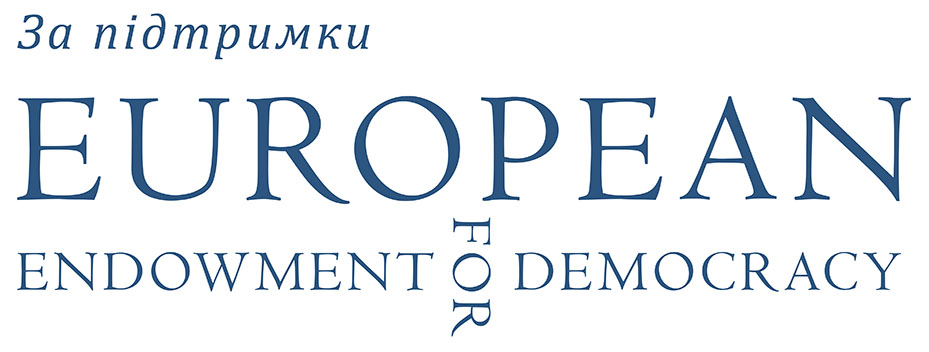Maritime Security of Ukraine. A Reference Work. (12) The Legal Aspects of Hydrocarbon Extraction in the Exclusive Economic Zone of Ukraine

Bohdan USTYMENKO,
M.J., Attorney at Law
Tetiana USTYMENKO,
S.J.D., professor,
Department of Civil Law and Procedure
National Academy of Internal Affairs
From the editors of BlackSeaNews
On 7 December 2021, the interdepartmental working group chaired by Secretary of the National Security and Defence Council (NSDC) of Ukraine Oleksiy Danilov completed work on the draft Maritime Security Strategy of Ukraine, a document initiated by President of Ukraine Volodymyr Zelensky.
The strategy was developed taking into account the current experience of the world's leading maritime powers, the positions of maritime law scholars, the proposals of 16 government agencies, independent experts, and business associations. The working group members approved the draft, and the final text of the document, after coordination of some positions, was sent to the President of Ukraine and members of the NSDC of Ukraine.
The strategy took into account a lot of proposals aimed at solving problems that had been repeatedly addressed in the publications by BlackSeaNews authors. Therefore, the editorial board has decided to create a concise and clear reference work based on the contributions from our authors, which looks at the terminology and problems related to maritime security and provides expert explanations.
Contents
(1) The State Border of Ukraine at Sea
(3) The Exclusive Economic Zone and the Continental Shelf
(4) Ukraine's Maritime Borders With Turkey and Romania
(5) Ukraine's Maritime Borders With the Russian Federation
(6) "Historical Waters" of the Sea of Azov and the Kerch Strait
(7) "Internal Waters" and Borders in the Sea of Azov and the Kerch Strait
(8) The Tuzla Island Conflict and the Agreement Under Duress
(11) Foreign Military Exercises in the Exclusive Economic Zone of Ukraine
(12) The Legal Aspects of Hydrocarbon Extraction in the Exclusive Economic Zone of Ukraine
(13) The Prohibition Against Vessels and Ships Entering the 12-Mile Zone of the Crimean Peninsula
(14) Threats of Maritime Formats Involving the Russian Federation
(15) Necessary Legal Measures Ukraine Should Take
* * *
Recent geological, geophysical and drilling operations in various regions have proved the offshore areas and continental slopes to host a wide range of mineral resources, including oil and gas, thus, confirming both the feasibility and the economic value of shelf exploration.

In particular, exploration of the Ukrainian shelf of the Black and Azov seas has yielded considerable mineral reserves, including up to 1583.5 billion cubic meters of natural gas and up to 409.8 million tons of crude oil, or more than 30 percent of Ukraine's total hydrocarbon reserves. At the same time, only 4 percent of them have been extracted, compared to almost 70 percent of the explored coastal hydrocarbon deposits.
Meanwhile, taking into account Russia’s propensity for anti-competitive practices and monopoly schemes, one of its reasons for occupying Crimea was getting access to the peninsula’s energy resources.
The earlier forecasts of the American IHS CERA consulting firm on Ukraine’s prospects in traditional and non-traditional natural gas production clearly hadn’t gone unnoticed in the RF.
According to the IHS CERA, by 2030, Ukraine could reach the mid-1970s gas production levels, which meant that besides fully meeting the domestic demand, the country would be able to export natural gas to Central and Eastern Europe, thus, squeezing out the Russians.
The northwestern sector of the Black Sea between Crimea and Odessa region was believed to be particularly promising — the assumption reaffirmed by ExxonMobil and OMV’s successful offshore explorations of the neighboring Romanian sector.
Needless to say, energy security is given special attention in the current National Security Strategy of Ukraine.
As far back as 1996, the Cabinet of Ministers of Ukraine (CMU) approved the Program of Development of Hydrocarbon Resources of the Ukrainian sector of the Black and Azov Seas. However, given the current occupation of not only Sevastopol and the Autonomous Republic of Crimea, but also, the waters around the Crimean peninsula, the Program certainly calls for an update.
In the meantime, let’s take a closer look at the provisions of international maritime law in the area of sovereign rights and the jurisdiction of a coastal state over the extraction of minerals, including hydrocarbons, within its exclusive economic zone.
Article 56 of the United Nations Convention on the Law of the Sea (UNCLOS) states that in its exclusive marine zone (hereinafter referred to as the EEZ), a coastal state, inter alia, has sovereign rights over the exploration, development and conservation of both living and non-living natural resources in the waters covering the seabed, on the seabed and in the subsoil, as well as over the management of these resources.
In addition, according to the relevant UNCLOS provisions, within its EEZ, the coastal state has jurisdiction over the construction and use of artificial islands, installations and structures, marine scientific research, protection and conservation of the marine environment, as well as other rights and obligations under the Convention.
At the same time, Article 50 of UNCLOS stipulates that in its EEZ, the coastal state has the exclusive right to construct, authorize and regulate the construction, operation and use of:
- artificial islands
- installations and structures for the purposes provided for in Article 56 and other economic needs
- installations and structures which may interfere with the exercise of the rights of the coastal state in the EEZ.
Also, the coastal state has exclusive jurisdiction over such artificial islands, installations and structures, including jurisdiction with regard to customs, fiscal, health, safety and immigration laws and regulations. Artificial islands, installations and structures do not possess the status of islands.
They have no territorial sea of their own and their presence does not affect the delimitation of the territorial sea, the exclusive economic zone or the continental shelf. (Article 60, Paragraph 8, UNCLOS).
Meanwhile, on the basis of UNCLOS, Ukraine has adopted its own legislation in regard to the EEZ. Thus, in accordance with the provisions of Article 4 of the Law of Ukraine On the Exclusive Marine Economic Zone, in its EEZ Ukraine has:
- sovereign rights for the exploration, development and conservation of the living and non-living natural resources in seabed and subsoil waters, as well as for the management of those resources and other economic exploration and development activities in the designated area, including the production of energy through the use of water, currents and wind
- jurisdiction provided for by the relevant provisions of the Law and the rules of international law for the creation and use of artificial islands, installations and structures, carrying out marine scientific research and protection and conservation of the marine environment
- other rights provided by the Law, other legislative acts of Ukraine and generally recognized norms of international law.
The sovereign rights and jurisdiction of Ukraine regarding the seabed of the exclusive (marine) economic zone and its subsoil are implemented in accordance with the legislation of Ukraine regarding the continental shelf and the Subsoil Code of Ukraine.
For instance, Article 411 of the Economic Code of Ukraine (hereinafter — the EC of Ukraine) also stipulates that in the marine EEZ of Ukraine, the state has exclusive right to construct, authorize and regulate the construction, operation and use of artificial islands, installations and structures for marine scientific research, exploration and development of natural resources and other economic purposes in accordance with the legislation of Ukraine.
* * *
In conclusion, we would like to stress that to create favorable conditions for the hydrocarbon production on the shelves of the Black and Azov seas and ensure Ukraine’s energy independence, the state should:
- beginning in 2020, intensify hydrocarbon production in the Ukrainian sector of the shelves
- in order to fulfill the regulations of the Marine Doctrine of Ukraine for the period up to 2035 approved by the Cabinet of Ministers of Ukraine, in 2020, adopt the Strategy for the development of hydrocarbon resources in the Ukrainian sector of the Black and Azov seas.
* * *
References:
1. Pro zatverdzhennya Zagalnoderzhavnoi programy rozvytku mineralno-syrovynnoi bazy na period do 2030 roku: Zakon Ukrainy vid 21 kvitnya 2011 roku № 3268–VI. (On Approving the National Program for Development of the Mineral Resource Base of Ukraine for the Period up to 2030: Law of Ukraine #3268–VI from April 21, 2011), URL: https://zakon.rada.gov.ua/laws/show/3268-17.
2. Pro zatverdzhennya Morskoi doktryny Ukrainy na period do 2035 roku: Postanova Cabinetu Ministriv Ukrainy vid 07.10.2009 r. № 1307 (On Approving the Marine Doctrine of Ukraine for the Period Until 2035: Resolution of the Cabinet of Ministers of Ukraine #1307 from October 7, 2009), URL: https://zakon.rada.gov.ua/laws/show/1307-2009-%D0%BF.
3. Viiny – XXI: Polihibressiya Rosii. - Kyiv: Tsentr globalistyky «Strategiya ХХІ», 2017.- 244 s. (Wars — XXI: Russia’s Polyhybression, Kyiv, Center for Global Studies «Strategy XXI», 2017, p. 244), URL: https://geostrategy.org.ua/images/wars21_UA_19.pdf.
4. Pro rishennya Rady natsionalnoi bezpeky і oborony Ukrainy vid 6 travnya 2015 roku «Pro Strategiyu natsionalnoi bezpeky Ukrainy»: Ukaz Prezidenta Ukrainy vid 26 travnya 2015 roku № 287/2015 (On the Decision of the National Security and Defense Council of Ukraine from May 6, 2015 “On the National Security Strategy of Ukraine”: Presidential Decree of May 26, 2015 No. 287/2015), URL: https://zakon.rada.gov.ua/laws/show/287/2015.
5. Pro programu osvoyennya vuglevodnevykh resursiv ukrainskogo sectora Chornogo i Azovskogo moriv: Postanova Cabinetu Ministriv Ukrainy vid 17 veresnya 1996 roku № 1141 (On the Program of Development of Hydrocarbon Resources of the Ukrainian Sector of the Black and Azov Seas: Resolution of the Cabinet of Ministers of Ukraine from September 17, 1996 No. 1141), URL: https://zakon.rada.gov.ua/laws/show/ru/1141-96-%D0%BF.
6. Сonventsiya Оrganizatsii Оb’yednanykh Natsiy z morskogo prava (ratyfikovana Zakonom Ukrainy «Pro ratyfikatsiyu Сonventsiya Оrganizatsii Оb’yednanykh Natsiy z morskogo prava 1982 roku ta Ugody pro implementatsiyu Chastyny XI Сonventsiya Оrganizatsii Оb’yednanykh Natsiy z morskogo prava 1982 roku» № 728-XIV vid 03.06.1999 r.) (United Nations Convention on the Law of the Sea (ratified by the Law of Ukraine # 728-XIV from June 3, 1999 «On Ratification of the 1982 United Nations Convention on the Law of the Sea») URL: https://zakon.rada.gov.ua/laws/show/995_057.
7. Pro vyklyuchnu morsku (economichnu) zonu: Zakon Ukrainy vid 16.05.1995 r // Vidomosti Verkhovnoi Rady Ukrainy. - 1995 r № 21, stattya 152. (On the Exclusive Marine (Economic) Zone of Ukraine: Law of Ukraine from May 16, 1995. Bulletin of the Verkhovna Rada of Ukraine #21, 1995, article 152.)
8. Gospodarskyi kodeks Ukrainy vid 16.01.2003 r. // Ofitsiinyi visnyk Ukrainy.- 2003 r., № 11, stor. 303, stattya 462. (The Economic Code of Ukraine of January 16, 2003. The Official Bulletin of Ukraine #11, 2003, p. 303, article 462).
9. Pro ugody pro rozpodil produktsii: Zakon Ukrainy vid 14.09.1999 r. (On Product Sharing Agreements: Law of Ukraine of September 14, 1999), URL: https://zakon.rada.gov.ua/laws/show/1039-14.
* * *
 This publication has been produced with the support of the European Endowment for Democracy (EED). Its contents do not necessarily reflect the official opinion of EED. Responsibility for the information and views expressed in this publication lies entirely with the authors.
This publication has been produced with the support of the European Endowment for Democracy (EED). Its contents do not necessarily reflect the official opinion of EED. Responsibility for the information and views expressed in this publication lies entirely with the authors.
More on the topic
- 19.12.2021 Maritime Security of Ukraine. A Reference Work. (15) Necessary Legal Measures Ukraine Should Take
- 19.12.2021 Maritime Security of Ukraine. A Reference Work. (14) Threats of Maritime Formats Involving the Russian Federation
- 19.12.2021 Maritime Security of Ukraine. A Reference Work. (13) The Prohibition Against Vessels and Ships Entering the 12-Mile Zone of the Crimean Peninsula
- 18.12.2021 Maritime Security of Ukraine. A Reference Work. (11) Foreign Military Exercises in the Exclusive Economic Zone of Ukraine
- 17.12.2021 Maritime Security of Ukraine. A Reference Work. (10) What Mandatory Procedure for the Delimitation of the Maritime Border Between Ukraine and Russia Can Be Adopted
- 16.12.2021 Maritime Security of Ukraine. A Reference Work. (9) The Delimitation of the Sea of Azov and the Kerch Strait According to the UN Convention on the Law of the Sea
- 15.12.2021 Maritime Security of Ukraine. A Reference Work. (8) The Tuzla Island Conflict and the Agreement Under Duress
- 14.12.2021 Maritime Security of Ukraine. A Reference Work. (7) "Internal Waters" and Borders in the Sea of Azov and the Kerch Strait
- 13.12.2021 Maritime Security of Ukraine. A Reference Work. (6) "Historical Waters" of the Sea of Azov and the Kerch Strait
- 12.12.2021 Maritime Security of Ukraine. A Reference Work. (5) Ukraine's Maritime Borders With the Russian Federation
- 11.12.2021 Maritime Security of Ukraine. A Reference Work. (4) Ukraine's Maritime Borders With Turkey and Romania
- 10.12.2021 Maritime Security of Ukraine. A Reference Work. (3) The Exclusive Economic Zone and the Continental Shelf